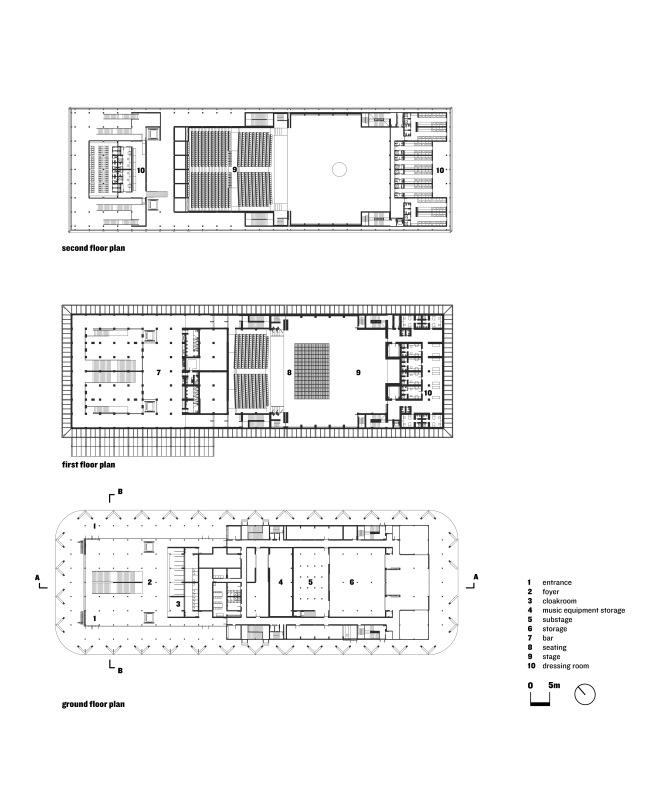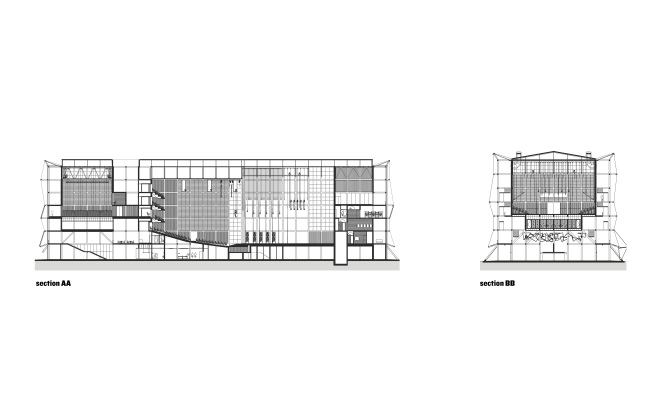From the absolute blackness of the auditorium at its heart to its ethereal translucent skin, Smiljan Radić’s Teatro Biobío in Concepción, Chile, is a theatrical performance of light
Like a Matryoshka, Smiljan Radić’s Teatro Regional Biobío in Concepción, Chile, grows from one layer of the building to the next. In a set of Russian nesting dolls, the outermost wooden figure separates at the middle, splitting top from bottom. Such division reveals a smaller nearly identical figure inside, which in turn has a smaller version inside it, and so on. When opening the first doll, the user generally knows what to expect – until the last, solid doll suddenly brings the game to an end. In Radić’s theatre, every layer takes on a different nature, with its own rules and aesthetics: from the solid play-spaces at its core to the translucent facades, from the volume of the building to the city outside and the landscape beyond.

Siteplan bio bio architectural review
Hidden rooms and rehearsal spaces only reveal themselves once inside the building, with changing material expressions, colour palettes and atmospheres. There are green rooms, yellow wooden surfaces and red fire stairs. There are black wooden surfaces and pieces of brown, organic coconut fibre covering floors, walls and ceilings for their acoustic properties. Through transparencies, openings and spatial connections, the pieces of the building coalesce into a unified whole.
There is a long history of theatre, as an activity and programme, operating independently of a specific building type: plays in the streets, churches, palaces and public spaces. As an autonomous construction, the theatre only emerged during the Renaissance in the 15th and 16th centuries. Gradually, the typology evolved into the articulation of two spheres – the public (audience) and the private (theatrical machinery) – which overlap on stage. This fundamental composition or arrangement was nothing other than a recuperation of classical theatre, and not very different from the religious cloister typology, in which the private space of monks and the public sphere of the filigrees meet in the altar sacral space.
‘This is a building not only for the city but for the whole region, an institution for people to nurture’
The most radical design operation Radić employs in the Teatro Regional Biobío is to reverse the arrangement of conventional theatres into a much more complex and subtle compositional strategy. What is usually hidden at the back of the building is folded into the core. Internal dark voids in the building render the theatre auditoriums in an absolute black that seems to absorb light. The main room, seating 1,200 people, is a striking cube – black in every single detail and with sides measuring about 20m. Its height, proportions and contrast with the bright space outside provides an institutional weight to the space, a similar effect Radić achieved in the basement exhibition space of the Museo Precolombino in Santiago, Chile, a few years earlier. A twin chamber hall, smaller but equally dark, seats 250 people.

Maqueta teatro biobio architectural review
The PTFE membrane has the appearance of white fabric, disguising the concrete frame beneath. At night this glows like a shadow theatre. Diagonal legs meet the ground, echoing the concertina form of the theatre’s facade
Outside these black boxes, the theatre space is dominated by luminous offices, halls, corridors and stairs, involving the public in a collective and desacralised performance. Such a strategy pushes the theatre building as a typology into new (and also old) secular directions. Blurring boundaries between the internal space of the play and the external space of the public challenges conventional arrangements. The inner life of the building, with the audience moving through the six floors of the theatre, becomes amplified by the external layer of the building made of a flexible PTFE membrane: a teflon-coated fibreglass that looks like translucent white fabric. From the total darkness of the inner rooms, to the luminous intermediate circulation spaces, to the whiteness of the building exterior, the building reinvents itself in every layer.

In construction architectural review
Between the dark inner spaces and the shell facade, there is another element to the theatre, a doll of a different kind. An insistent 3.9 x 3.9m concrete grid of 300 x 300mm columns and beams ‘stubbornly’ fills the space in between, says Radić. Rehearsal rooms of different shapes and sizes emerge from the unexpected and labyrinthine circulation, filling the voids of the surrounding gridded space. Grids are a fundamental ordering principle in this building: they take on the role of infilling, measuring and ‘occupying every corner’. For Alberti, the grid promised to construct space and drawing, measuring with accuracy for the first time. For Radić, the concrete structure controls space across the building’s width (eight modules), length (26 modules) and height (six floors), dividing the large volume (98,000m3) into parts, giving order and measure to the whole. Structural plans of the concrete grid are carefully tailored to the meticulous specification of dimensions, with rebars in green and red lines and numbers. The drawing resembles dressmaking patterns rather than a calculated architectural or engineering plan.
In stark contrast to the large voids of the performance spaces – cubes full of air, of ‘black air, a darkness with misty air’ in the words of Radić – the three-dimensional concrete grid introduces density, recalling the scaffolding of conventional stage machinery and framing the building’s circulation within its beams and columns, letting all the light in.
Diagonals are introduced in the square grid before it touches the ground, forming a sandwich between the foundation slab and the first level floor plate that acts as a rigid diaphragm for the building. A highly distributed weight system is engineered to allow for slender foundations, which are not very deep for a large building only a few kilometres from the epicentre of an earthquake that devastated the city in 2010. From tsunamis to earthquakes, disaster has been a recurring phenomenon in Concepción. The whole beam-column structure, initially designed using a structure of 200 x 200mm beams, was enlarged to 300 x 300mm to reinforce solidity, resistance and resilience.
‘Not a decorated black box or camera obscura, this white, continuous volume ignited strong public opinion among the Concepción citizens’
Both the internal grid and the tent fabric outside the theatre represent obsessions of the architectural discipline seen in other buildings by Radić, such as the NAVE performing arts centre and CR House, both in Santiago. At night, the facade acts as a lantern, working in the mode of a shadow theatre projected in the faces of the translucent shell shining as a spectacle for the city. During the day, or when there is no play, the building becomes inertly opaque. Most of the time, the theatre appears to be a vast, pale volume, occasionally blending in with the fog, simultaneously undetectable and uncanny.
Although only a few hundred metres from the city centre, the building is not part of the dense urban fabric. Directly on the riverfront and separated from pedestrians by a highway and train tracks, it is an autonomous figure next to other out-of-scale objects: a shopping mall and a memorial marking the earthquake on 27 February 2010 (AR April 2016). The relationship between institutions and buildings is fundamental. As a large regional building, not only serving the city of Concepción, the administration has found it difficult to keep the building open when there is no show on; its separateness from the city turns it into a destination, rather than an integral part of citizens’ routes; and its civic administration makes it difficult for cafés, restaurants or bookshops to open in the space. As a result, the liveliness of the building has been slow to build, with much of the interior sitting vacant, waiting to be unlocked and thrive. This is a building not only for the city but for the whole region, an institution for people to nurture.
In 2011, Radić won the public competition organised by Chile’s Ministry of Cultures, Arts and Heritage for a public cultural infrastructure in Concepción. Taking seven years to build, Teatro Regional Biobío opened in March 2018 to a mixed reception. Not a decorated black box or camera obscura, this white, continuous volume ignited strong public opinion among the Concepción citizens, even though it had been highly anticipated after the abandonment, due to political rivalries and lack of funding, of Borja Huidobro’s initial proposal for the site. Internationally, however, the theatre has been much celebrated. Speculative exploration such as this – an unconventional building, mainly due to its size and use of unusual materials such as coconut fibre and wrapping in PTFE membrane – propels the discipline into new territory.
In March 2020 in Concepción, the second largest city of Chile, a group of protesters gathered in the plaza in front of the theatre to reject the constitutional changes most people in the streets have demanded in the social unrest that began in October 2019. The night before in the city’s main square, the police shot a young man protesting for a new constitution. Since the beginning of the social unrest and political crisis dividing the country, many institutional and cultural buildings have been vandalised across Chile – but despite multiple riots and manifestations in Concepción, the Teatro Regional Biobío remains intact. This is perhaps a signal of how the building is not yet part of the people’s representation system of values, still not physically attached to the city, to their everyday lives. Theatres exist to tell stories that connect people with each other, places with other places, and time with other times.
Teatro Biobío, Concepción, Chile
Architect: Smiljan Radić with Eduardo Castillo and Gabriela Medrano
Structural engineer: B & B Ingeniéria and Estructural
Photographs: Cristóbal Palma
This piece is featured in the AR April 2020 issue on Darkness – click here to buy your copy today
 Architectural Review Online and print magazine about international design
Architectural Review Online and print magazine about international design













